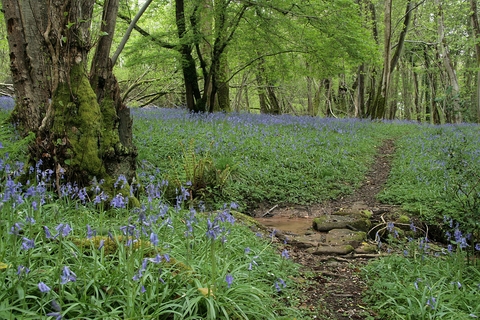A financial boost for Gwent’s wildlife arrived in 2020 as amongst the lockdowns, restrictions and home working, the Welsh Government announced a new grant fund, a Sustainable Management Scheme Fund (SMS) for Natura 2000 sites.
These are special sites that are recognised as being important at a European level, which include those designated as Special Areas for Conservation or SACs.
Gwent has several and we manage two of them - Prisk Wood SSSI and Piercefield Wood SSSI that, along with 14 other woodland sites, form part of the Wye Valley Woodlands SAC, straddling the England/Wales border along the River Wye.
We were delighted to attain a grant award for over £170,000 for our ‘Enhancing the Wye Valley Woods Project’.
The project is designed to implement a range of practical techniques to improve the ecological diversity and connectivity of nationally important woodland habitats, with our woodland nature reserves being some of the best wildlife woods, in one of the best and most important areas for woodland conservation in Wales.
We were also able to include three of our other nature reserves in the project, Pentwyn Farm SSSI, Wyeswood Common and Dixton Embankment Nature Reserves, all that either buffer the SAC sites or in the case of Dixton Embankment, it buffers the adjacent River Wye SAC.
The project officially started back in October 2020, and the works are varied and designed to benefit the sites important habitats and species, but also to make improvements for visitors to the sites.
During last winter, old, veteran pollarded trees, were re-pollarded by specialist tree surgeons to prolong their longevity, and elsewhere, others will be given more light and space to grow. Our reserves staff work to achieve this by felling the younger trees that are growing around them, a process known as halo-thinning.
Ash-dieback is badly affecting Ash trees within our nature reserves as it is across Gwent and so the Trust is actively leaving the majority of infected trees on our nature reserves to survive where we can, providing opportunities for trees to show natural resistance to the disease and also, where they succumb to the disease, creating an abundance of deadwood to benefit wildlife.
However, where diseased and dying trees endanger access within our nature reserves, such as along footpaths, roadsides and at car parks, we have had to make the difficult decision to fell these trees, making access paths and rides safe for staff to manage the sites in the future and safe for people to visit and get close to nature. The felling will have some benefits through creating more open and sunny conditions along paths, rides and glades which will improve conditions for woodland ground flora, stimulating greater natural regeneration of trees and shrubs, all of which will enhance both species and structural diversity in our woodland habitats. Therefore the grant is a timely one and is helping to fund this expensive contract work across project sites.
Other habitat improvements carried out courtesy of the grant, will see staff and volunteers restoring ponds, controlling Invasive Non-Native Species (INNS) such as Cherry Laurel, managing scrub and planting a new generation of trees that will, over time, become the veterans of the future.
The project is also improving our scientific knowledge and understanding of these reserves, as we have been sampling saproxylic or ‘deadwood invertebrates’ via ‘interception traps’, designed to capture flying insects.
Autumn sampling recorded almost 100 species of invertebrates with six saproxylic species that are Nationally Scarce. These include the first recording for the Wye Valley Woodlands SAC of a silken fungus beetle, a brown tree ant that nests in the decaying heartwood of old trees, a rove beetle that lives beneath the bark on fresh dead wood, a flower beetle associated with dead ivy and a couple of species that are associated with bracket fungi, one of which grows on old blackthorn stems.
This all demonstrates the need for deadwood at all stages of decay, across a whole range of woody species and conditions. And, that the maturity of these woodlands is part of the key to their diversity and this research all helps refine our management of these sites.
Staff will also be promoting the use of natural flood management techniques by creating debris dams in Prisk Wood, to ‘slow the flow’ of water within the network of small streams. Fixed point photography is being set where we are pollarding, felling, and restoring habitats, which when replicated periodically in the future, will help us observe habitat changes, which we will use to replicate or adapt for future management.
New equipment such as chainsaws and mechanical tree felling wedges are being funded to help staff implement the project improvements and maintain the sites in the future. Last but not least, access for visitor will be improved through investment in better access points, new interpretation panels, signs and general access improvements.
All in all, this grant has been very welcome and also necessary in helping us to both enhance our nature reserves and in creating a network of well-managed, connected and resilient wildlife habitats that contribute to a national ‘nature recovery network’.

